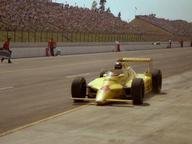Quiz Answer Key and Fun Facts
1. Sir Stirling Moss was one of the most successful racers of the 1950s, taking 16 F1 race wins on his way to finishing as the championship runner-up for four years in a row between 1955 and 1958. To which multiple world champion did he lose out on three of those four occasions?
2. Scottish racing driver David Coulthard won some of the most prestigious F1 races during his career, taking victory twice at both the British and Monaco Grand Prix. However, his 13th and last win came at which event?
3. Englishman Tony Brooks won six F1 races in the late 1950s. What nickname did he gain thanks to the career he studied for prior to his success in motor racing?
4. John Watson, who raced for the McLaren team from 1979 to 1983, is noted as the first driver to win a F1 race in a car with what feature?
5. In 1999, Eddie Irvine nearly ended which team's run of 20 years without a drivers' world championship, when he finished as runner-up to Mika Hakkinen by just two points?
6. 1950s F1 racer Peter Collins won three grand prix in a career that was cut short by his death following an accident at the 1958 German Grand Prix. At which circuit did that tragic event occur?
7. Johnny Herbert had to be lifted into his car for his first F1 race in 1989 (due to injuries sustained the previous year) and, ironically, had to be lifted out of his car at his last F1 race in 2000 after crashing heavily. For what teams was he driving on these two (painful) occasions?
8. Innes Ireland took his sole F1 victory at the 1961 United States Grand Prix. At which circuit was this race held?
9. When Peter Gethin won his one and only F1 race in 1971, he did it by breaking the record for the fastest F1 race of all time. At which grand prix did this achievement occur?
10. Many non-championship F1 races held over the years took place on circuits round the UK and consequently there have been lots of British winners of these races. Which of the following groups include British drivers notable for having won multiple non-championship F1 races?
Source: Author
Fifiona81
This quiz was reviewed by FunTrivia editor
gtho4 before going online.
Any errors found in FunTrivia content are routinely corrected through our feedback system.
